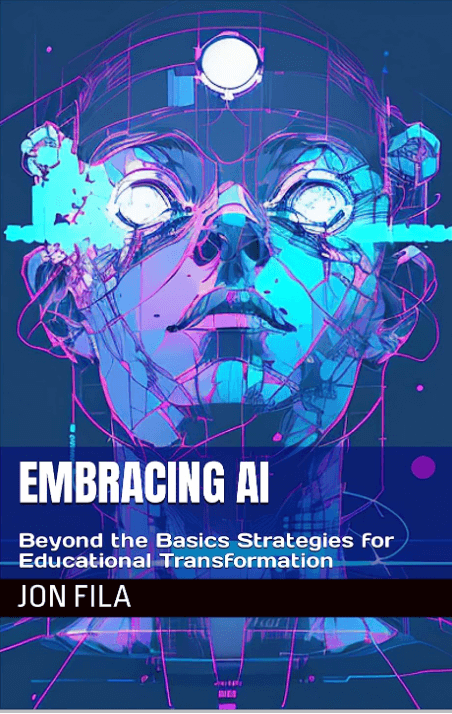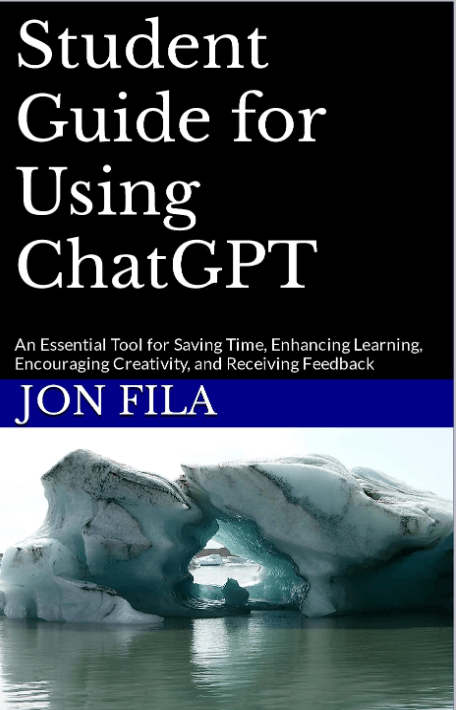Jon Fila started seeing student submissions that looked like they could be AI-generated in the last year so he knew he had two options—ban it or embrace it.
“I started getting submissions that looked a little bit off to me, like the proper formatting I’m used to from 12th grade English students. I started hearing more about AI, so I connected those dots,” said Fila, an English teacher at Intermediate School District 287’s Northern Star Online school. “I was also finding ways to use it as a teacher and how it might help fix some of the issues in education.”



ISD 287 English teacher Jon Fila has written three books on the topic of AI in education.
Fila started researching more, working with the tools, and has now written three books on the subject and is training educators across the country.
“I try to acknowledge that of course students are going to use it to get out of work, but some fields are using it with remarkable results. It’s a tool that many jobs are excited about and we’re telling students not to use it. I show examples of how we might be able to use it,” he said. “Today is the worst it’s ever going to be. It will become more accessible. If something is inevitable, we can’t fight it.”
In May, the U.S. Department of Education’s Office of Educational Technology released the report, “Artificial Intelligence and the Future of Teaching and Learning: Insights and Recommendations.”
The report describes AI “as a rapidly-advancing set of technologies for recognizing patterns in data and automating actions,” and “guides educators in understanding what these emerging technologies can do to advance educational goals—while evaluating and limiting key risks.”
Key insights from the report include:
- AI enables new forms of interaction. Students and teachers can speak, gesture, sketch and use other natural human modes of communication to interact with a computational resource and each other. AI can generate human-like responses, as well. These new forms of action may provide supports to students with disabilities.
- AI can help educators address variability in student learning. With AI, designers can anticipate and address the long tail of variations in how students can successfully learn—whereas traditional curricular resources were designed to teach to the middle or most common learning pathways. For example, AI-enabled educational technology may be deployed to adapt to each student’s English language abilities with greater support for the range of skills and needs among English learners.
- AI supports powerful forms of adaptivity. Conventional technologies adapt based upon the correctness of student answers. AI enables adapting to a student’s learning process as it unfolds step-by-step, not simply providing feedback on right or wrong answers. Specific adaptations may enable students to continue strong progress in a curriculum by working with their strengths and working around obstacles.
- AI can enhance feedback loops. AI can increase the quality and quantity of feedback provided to students and teachers, as well as suggesting resources to advance their teaching and learning.
- AI can support educators. Educators can be involved in designing AI-enabled tools to make their jobs better and to enable them to better engage and support their students.
Fila said that he has started small on engaging students with the technology.
“I give the AI response and students are able to talk about it or come up with sources to support or detract against the argument AI made. Some of the things aren’t accurate, so we must teach them how to interact with it,” he said.
Fila starts small when working on this topic with educators, as well.
“It isn’t meant to replace anything but let’s think about ways to incorporate it with what we are already doing. The uses of the tools are only as good as how we use them,” he said.
Fila encourages other educators to just start using the programs and finding how they can be useful, especially with smaller tasks.
“You have to figure out what problem you are trying to solve. Otherwise, it would just be recreating work we are already doing,” he said. “Writing a five-question quiz in a learning management system would take me an hour. I can have the system write a 30-question quiz and then work through them, pick the ones I like and export them in the way I need in about 15 minutes,” he said.
“There’s room for improvement on a lot of things we do. Why not use this to move us forward? Whatever you think it’s for today, there’s probably more to it than that.”
Working with your library media specialist
The Information and Technology Educators of Minnesota (ITEM), the organization of state media specialists, encourage all educators to reach out to their school or district’s library media specialist with questions about these new, emerging technologies or to collaborate on a student lesson regarding AI and programs like ChatGPT.
ITEM President-Elect Laura Gingras, a library media specialist in Waconia, said she is excited to share AI with her teachers and work with them on how it could be a helpful tool.
“If our teachers know how it works and its capabilities, they will be better able to recognize when their students are using it,” said Gingras. “When we teach our students about a creator’s rights and responsibilities, we talk about how to ensure others find us credible. By sharing our sources and explaining where we get our information, we prove that we took the steps to learn about a topic. If we just say, ‘I asked ChatGPT,’ it isn’t proving that we learned anything.”
Resources for educators
Digital citizenship curriculum
Common Sense Education has a digital citizenship curriculum, which uses digital citizenship lesson plans to address timely topics and prepare students to take ownership of their digital lives. The curriculum has lessons for all grade levels K-12 and can be found at www.commonsense.org/education/digital-citizenship/curriculum.
Free media literacy tool from AFT
The American Federation of Teachers has teamed up with NewsGuard to provide free access to their leading media literacy tool to all AFT members and their students and families. Included is a browser extension and mobile app that gives users real time access to “traffic light” news ratings and detailed “nutrition label -like” reviews describing the credibility of thousands of news and information websites. To access your free NewsGuard tool, go to www.newsguardtech.com/AFT.
Research, case studies, tools
The International Society for Technology in Education (ISTE) has numerous resources on their website, www.iste.org/areas-of-focus/AI-in-education. The site includes free professional development, educator guides, research, case studies, blog posts and podcasts.
Jon Fila’s website, www.jonfila.com, includes lessons and curriculum resources, in addition to ways where you can purchase his three books, “Student Guide for Using ChatGPT: An Essential Tool for Saving Time, Enhancing Learning, Encouraging Creativity, and Receiving Feedback,” “Educator Guide for Using ChatGPT An Essential Tool for Saving Time, Supporting Your Learners, and Thinking about AI for Education,” and “Embracing AI: Beyond the Basics Strategies for Educational Transformation.”
The U.S. Department of Education’s Office of Educational Technology is working to develop policies and supports focused on the effective, safe and fair use of AI-enabled educational technology. Their website, https://tech.ed.gov/ai/, includes listening session recordings, blog posts and the full report on AI and the future of teaching and learning.


